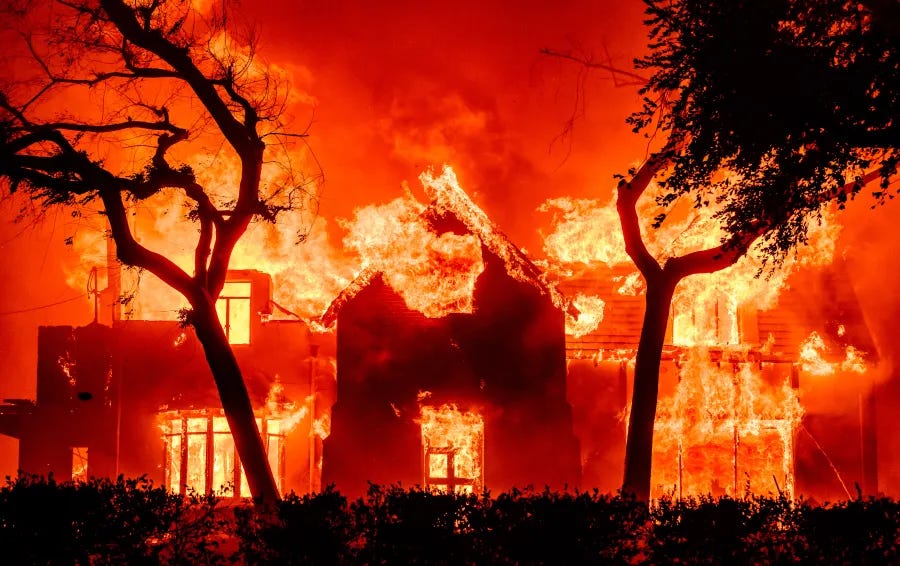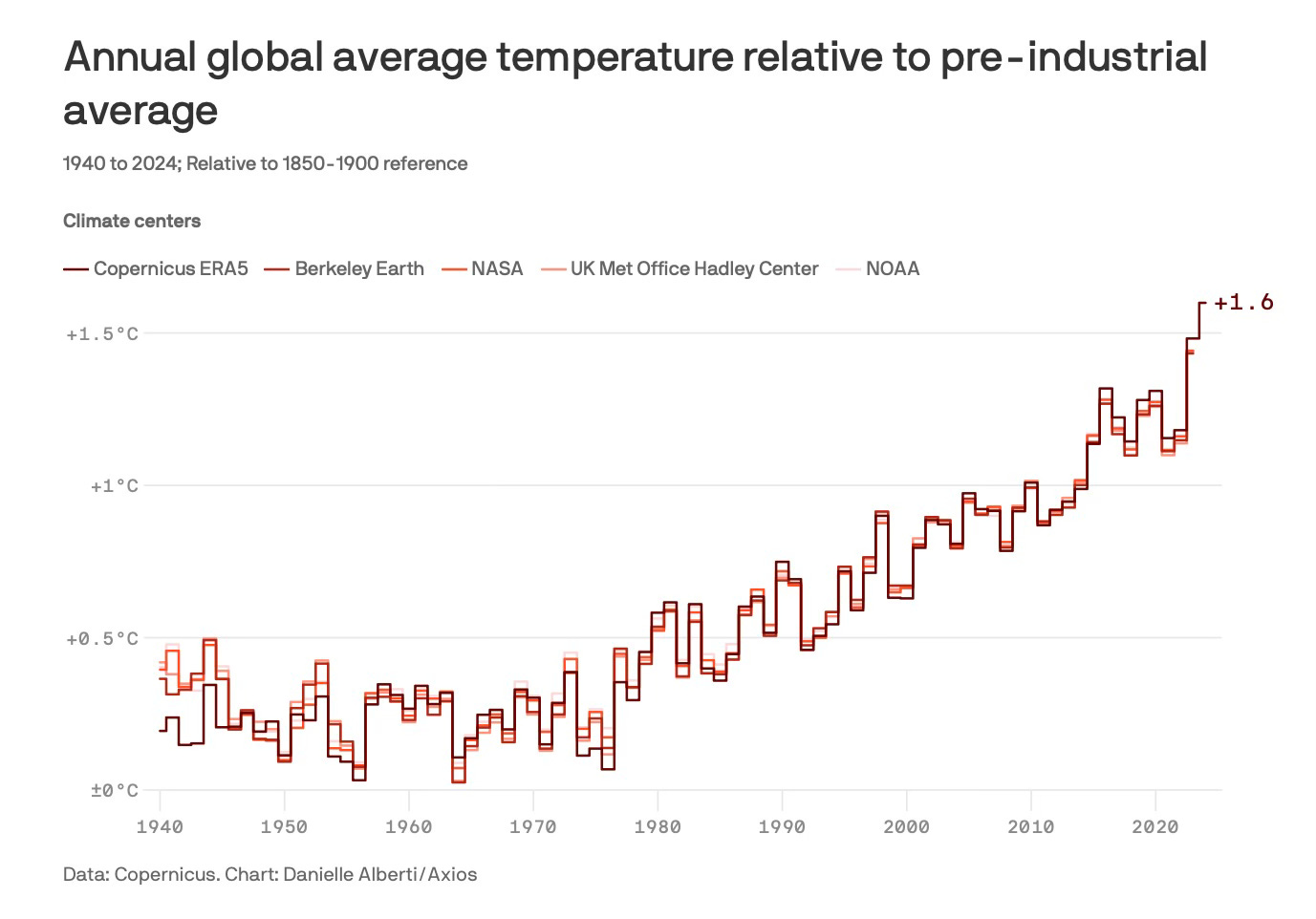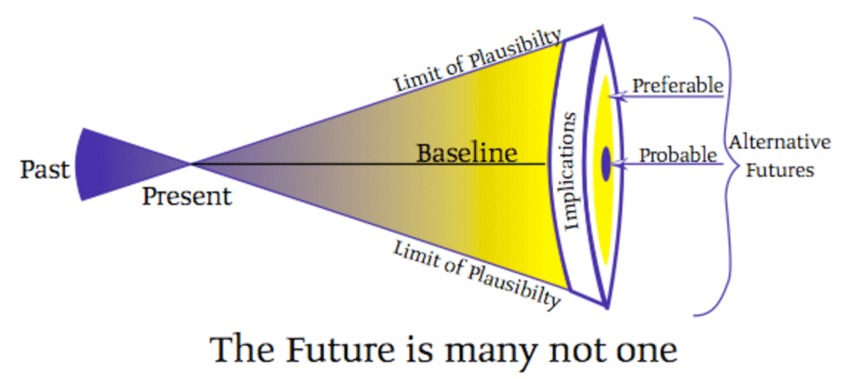You see the aftermath pictures and it’s like Gaza in terms of utter devastation — like somebody just wanted to completely wipe out this metro environment and make it uninhabitable.
The actual fire shots remind one of Dresden 1945.
Ten dead (and counting) and coming up on 10,000 structures destroyed.
What we keep getting schooled on here is the synergistic severity. LAFD can’t contain fires because it cannot command enough water via hydrants.
Who screwed that up?
The Anthropocene did. No metro area’s water system is built to handle that many fires spread over that large a landscape — as in, 20,000 acres. Until now, it would have been inconceivable to build such capacity — crazy even.
Now, not so much.
There are price tags and there are price tags.
Susan Crawford, THE expert on how climate change challenges both local governments and insurance companies, continues to warn of a potential real-estate crash worse than 2008:
Why Climate Change Will Wreck the Municipal Bond Market: It’s going to be worse than 2008.
Unpriced risk undermined the global economy during the financial crisis of 2008. Today, researchers say unpriced physical climate risk will lead to rapid declines in property values — and point out that this is already happening in some Florida markets. They often compare what’s happening now to the run-up to 2008. If the analogy holds, we will likely see disruption in other related financial structures. In particular, as the physical reality of climate change begins to have an effect on the attractiveness of bonds in risky areas, the ability of local governments to raise money to adapt to rapidly changing climate conditions may be undercut.
But comparing the effect of the 2008 unpriced risk on the municipal bond market with the potential effects of physical climate risk shows the suffering will likely be much greater this time. Today, there’s a direct, rather than indirect, connection between risk and public finance markets.
The key notion: climate change’s risk is not yet being sufficiently priced into really anything: stock markets, real estate markets, municipal bonds, homeowners insurance, national security, homeland security … nada.
Threat is racing ahead of adaptation, creating a massive ruleset gap.
And what happens when you have a ruleset gap? It’s the equivalent of Hegel’s dialectic: antithesis (new danger/reality) overwhelms thesis (old models/rules) and severe crisis unfolds, forcing synthesis (the new ruleset).
The 9/11 terror attacks are the classic here, but the 2008 Crash comes close.
We are headed toward something bigger, it would seem, with climate change — the sheer pervasiveness and simultaneity.
All the estimates you’ve been presented with to-date … none of them factor into the inescapability of it all — everything everywhere all at once.
And yeah, the multiverse is revealed: butterfly flaps its wings here and your community is gone while the one next over suffers not.
Can I join your branch of the sacred timeline? Because mine just got clipped!
Except we don’t have a Time Variance Authority to clean things up. No such Leviathan yet exists on climate change. But such scenario-based planning must emerge, otherwise we’re going to be chasing our tails non-stop on disasters.
As the death toll climbed from wildfires raging in California, scientists confirmed on Friday that the world has just experienced the first year in which temperatures exceeded 1.5C above pre-industrial times.
The milestone was confirmed by the European Union's Copernicus Climate Change Service (C3S), which said climate change is pushing the planet's temperature to levels never before experienced by modern humans.
The wording is key: levels never before experienced by modern humans.
Our climate changed future has arrived — way ahead of schedule.
The original predictions from years ago spoke of the danger of this occurring by 2050. Then the predictions shifted to 2040, then 2035, then 2030, and now it’s here — last year — in 2024.
Talk about a fast-forwarding: You’ve got about a half a century to get ready … no … wait a tick … a quarter century … which turns out to be right about NOW!
I mean, that’s gotta get your attention, right?
You know the old bit about it not being the heat but the humidity? Or it not being the cold but the wind chill?
You know, the whole it feels like thing?
Well, this should feel like a punch-to-your-face warning.
From America’s New Map:
Climate change renders Earth’s lower latitudes increasingly unsuitable for nation-states as we have known them. The North addresses this harsh reality or faces something far worse.
Two inevitabilities arise from the scientific community’s increasingly firm projections of climate change: First, higher latitudes (closer to poles) will experience significantly greater weather volatility— temperate zones made intemperate. Second, lower latitudes (closer to equator) will experience a harshening of their climes with increasingly frequent and extreme droughts accompanied by unlivable temperature ranges. In sum, the North’s climate grows frighteningly erratic while the South’s grows depressingly predictable.
“Frighteningly erratic” feels like this:
Floods, droughts, then fires: Hydroclimate whiplash is speeding up globally: New research links intensifying wet and dry swings to the atmosphere’s sponge-like ability to drop and absorb water
Crazy-ass swings between extremes, radically expanding the “cone of plausibility” regarding our shared environmental future.
Our multiverse grows … meaning the choices we make in the present carry vastly more weight, levering alternative futures.
Remember my dictum: scenario-based planning eliminates shock (I had no idea it could be like this!) but not surprise (I was sure we had more time to get ready!).
Climate change turns up the weather volatility like nothing humans have ever before experienced:
Los Angeles is burning, and accelerating hydroclimate whiplash is the key climate connection.
After years of severe drought, dozens of atmospheric rivers deluged California with record-breaking precipitation in the winter of 2022-23, burying mountain towns in snow, flooding valleys with rain and snow melt, and setting off hundreds of landslides.
Following a second extremely wet winter in southern parts of the state, resulting in abundant grass and brush, 2024 brought a record-hot summer and now a record-dry start to the 2025 rainy season, along with tinder-dry vegetation that has since burned in a series of damaging wildfires.
This is just the most recent example of the kind of “hydroclimate whiplash” – rapid swings between intensely wet and dangerously dry weather – that is increasing worldwide.
Here’s the actual cited study:
Published: 09 January 2025
Hydroclimate volatility on a warming Earth
Daniel L. Swain, Andreas F. Prein, John T. Abatzoglou, Christine M. Albano, Manuela Brunner, Noah S. Diffenbaugh, Deepti Singh, Christopher B. Skinner & Danielle Touma
Nature Reviews Earth & Environment volume 6, pages 35–50 (2025)
The abstract is compelling:
Hydroclimate volatility refers to sudden, large and/or frequent transitions between very dry and very wet conditions. In this Review, we examine how hydroclimate volatility is anticipated to evolve with anthropogenic warming. Using a metric of ‘hydroclimate whiplash’ based on the Standardized Precipitation Evapotranspiration Index, global-averaged subseasonal (3-month) and interannual (12-month) whiplash have increased by 31–66% and 8–31%, respectively, since the mid-twentieth century. Further increases are anticipated with ongoing warming, including subseasonal increases of 113% and interannual increases of 52% over land areas with 3 °C of warming; these changes are largest at high latitudes and from northern Africa eastward into South Asia. Extensive evidence links these increases primarily to thermodynamics, namely the rising water-vapour-holding capacity and potential evaporative demand of the atmosphere. Increases in hydroclimate volatility will amplify hazards associated with rapid swings between wet and dry states (including flash floods, wildfires, landslides and disease outbreaks), and could accelerate a water management shift towards co-management of drought and flood risks. A clearer understanding of plausible future trajectories of hydroclimate volatility requires expanded focus on the response of atmospheric circulation to regional and global forcings, as well as land–ocean–atmosphere feedbacks, using large ensemble climate model simulations, storm-resolving high-resolution models and emerging machine learning methods.
There’s a glimpse of your future: the need to “co-manage” drought and floods that alternate at an increasingly fast pace and increasingly higher severity.
Keep reading with a 7-day free trial
Subscribe to Thomas P.M. Barnett’s Global Throughlines to keep reading this post and get 7 days of free access to the full post archives.










